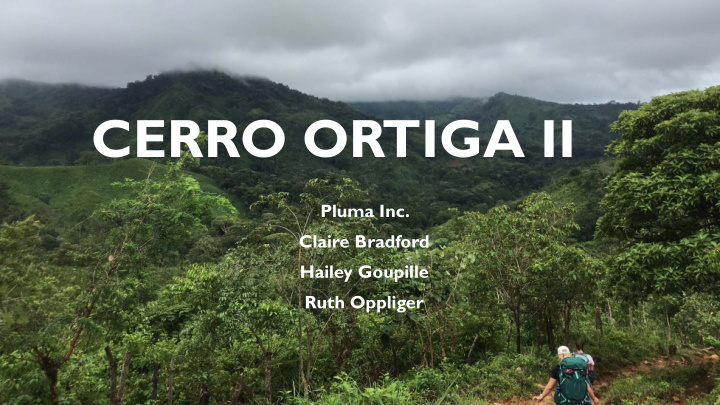



CERRO ORTIGA II Pluma Inc. Claire Bradford Hailey Goupille Ruth Oppliger
OUTLINE Pluma Inc. background Problem description Gravity-fed water system background Community background Final design Cost estimate Construction schedule Conclusion Questions
MISSION STATEMENT To design a water distribution system to meet the needs of the Cerro Ortiga II community members and provide knowledge of engineering water systems to assist the community in implementing the project. Pluma Inc. designs for the sustainable, economical, social, and the health and safety needs of the Cerro Ortiga II community.
PROBLEM DESCRIPTION Design gravity-fed water system Provide clean water for: 78 people 13 homes Redesign previous infrastructure Maximum budget: $8,000
GRAVITY FED WATER SYSTEM
COMMUNITY BACKGROUND Ngöbe-Buglé Comarca Population Size: 600 citizens Area:15-20 mi 2 Terrain Steep Hills Trail Condition Heavy Rain Remote Location
EDUCATION Points System Cost of Attendance: $5/year Classroom Environment On Site: K-9 th Off Site: 10 th -12 th Monday-Thursday: 8am- 12pm
WORK LIFE Subsistence agriculture Corn, cacao, yucca, plantains, coffee, bananas, rice Hand-made items Stores on site Salary jobs
TRADITION AND COMMUNITY LIFE Men and Women are equal Child-bearing begins at a young age Unions vs. Marriage Heavily hunted area No running water House Structure Thatched roof Dirt floors
GOVERNMENT AID $120/month per family $80/year for school supplies Free health clinic Every 3 months Dental, check-ups, testing, vaccinations Ministry of Health (MINSA) Previous water system
CHALLENGES Lack of structure and maintenance on water system Limited access to materials High cost for community Lack of knowledge of water system Interference from community members Community lacks a sense of ownership
SURVEY TECHNIQUES
WATER QUALITY Quality Number T est of Coliforms 1 19 2 9 3 4 4 12 5 14 Avg. 11.6
FLOW RATE AND DEMAND Source: Ground spring Flow Rate: 1.13gpm Total:1,600 gallons/day Allowable water usage: 20 gallons/person/day World Health Organization Minimum of 5 gallons/person/day for Basic Water Access
OLD SYSTEM Spring Box Chlorinator Holding Tank
Final Design FINAL DESIGN
SYSTEM OUTLINE Spring Box Chlorinator Rainwater Air Valve Catchment Holding Tank Yay Pipe Crossing Pressure Reducing System Tap Stand
SPRING BOX Old Infrastructure New Design
Spring Box Chlorinator Rainwater Air Valve Catchment Holding Tank Yay Pipe Crossing Pressure Reducing System Tap Stand
RAINWATER CATCHMENT System for laundry area Area will be dammed Roof area: 25 ft 2 Captures an average of 170 gallons/month Materials: Corrugated PVC 4 x 4 Wooden Posts
Spring Box Chlorinator Rainwater Air Valve Catchment Holding Tank Yay Pipe Crossing Pressure Reducing System Tap Stand
CHLORINATOR Recommend: Insert 3 tablets every 1-2 weeks Tablets: 200 grams 3 inch in diameter 70-90% available free chlorine Tablet dissolution rate: 5-7 days Study flowrate:12 gpm Cerro Ortiga flowrate:1.13 gpm Cost: $25 15 tablets/visit
Spring Box Chlorinator Rainwater Air Valve Catchment Holding Tank Yay Pipe Crossing Pressure Reducing System Tap Stand
HOLDING TANK Old Infrastructure New Design 2,000 gallons 4,500 gallon
Spring Box Chlorinator Rainwater Air Valve Catchment Holding Tank Yay Pipe Crossing Pressure Reducing System Tap Stand
PIPELINE T otal Pipeline: 8,180 ft (1.5 miles) Main Line: 2,500 ft Pipe Diameter 1.5 inch on main line 1 inch on branches Pipe material is SDR 26
Spring Box Chlorinator Rainwater Air Valve Catchment Holding Tank Yay Pipe Crossing Pressure Reducing System Tap Stand
AIR VALVE Air blockages can occur within a gravity fed water system Changes in elevation High pressures Air valve will be placed on Louisa’s branch The valve is closed when the http://plastomatic.com/arv.html system is running normally
Spring Box Chlorinator Rainwater Air Valve Catchment Holding Tank Yay Pipe Crossing Pressure Reducing System Tap Stand
PRESSURE REDUCING VALVE/PRESSURE BREAK TANK 2 ft. 2 ft. High pressures occur at the lower overflow end of the system Overall elevation change of 375 2 ft. outlet feet Pressures between 100 and 150 psi Pressure release valve Reduces pressure to 25 to 75 psi Pressure break tank Reduces pressure to atmospheric http://www.homedepot.com/p/Watts-3-4-in-Brass-FPT -x-FPT - Pressure-Reducing-Valve-3-4-LF25AUB-Z3/202922385
Spring Box Chlorinator Rainwater Air Valve Catchment Holding Tank Yay Pipe Crossing Pressure Reducing System Tap Stand
PREVIOUS PIPE CROSSING
PIPE CROSSINGS Crossing Length of T otal T ension Span (ft) (lbs) 1 38 395 2 83 985 3 26 250 4 25 233 5 34 322
Spring Box Chlorinator Rainwater Air Valve Catchment Holding Tank Yay Pipe Crossing Pressure Reducing System Tap Stand
TAP STANDS AND SHUT OFF VALVES 13 tap stands 4 x 4 wooden post Hose clamps Globe valves 5 shut off valves Used for maintenance
COST ESTIMATE Item Cost Pipeline $3,500 Pressure ReducingValve $180 Air Valve $30 Tanks $1,800 Pipe Crossings $700 Chlorinator $25 Rainwater Catchment $65 Taps $100 Transportation $400 Equipment $400 TOTAL $7,200
CONSTRUCTION SCHEDULE Start date: August 1, 2017 End date: November 1, 2017 Spring box: 7 days Holding tank: 7 days Pressure reducing valve/Pressure break tank: 1-6 days Pipeline: 41 days Laundry area: 6 days
CONCLUSION Next Steps: Apply for grant Transport materials Begin construction Continual maintenance Recommendations Formal water committee Monthly meetings Delegate maintenance
Questions?
Recommend
More recommend